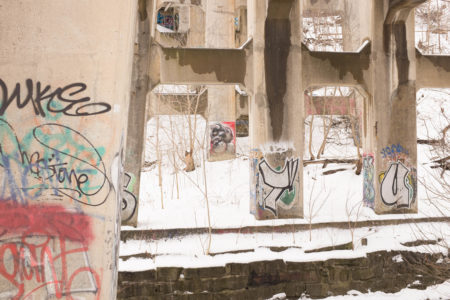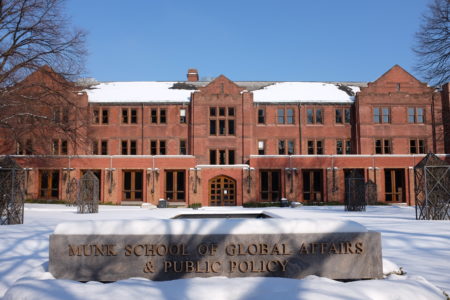Category: Toronto
This uncivil city
780 km of exercise walks since August have brought me much into contact with people on the sidewalks and pathways of Toronto. Particularly in the last couple of months, I have had the sense that people in general are stressed, frayed, and emotionally on-edge. I see this in their egocentrism: their determination to do as they wish and let hang any who question or obstruct them in doing whatever they feel entitled to, from walking dogs off-leash which then come charging up to me, to driving as though taking out a few pedestrians is a fair exchange for getting where they want faster, to raging out and screaming at people when asked to follow some basic legal requirement or expectation of civil conduct. Toronto strikes me less and less as a place where a desirable sense of community exists, and more as the anarchic arena in which millions of selfish desires overlap and clash.
It has now been a year — since the last March 8th — since I have been in voluntary COVID isolation, going beyond whatever confusing and contradictory public orders are in force to simply do what I can to minimize human contact and the risk of virus transmission. I’m certainly worn down myself, from lack of life-sustaining activities like voluntary associations with in-person meetings, from the stress of Toronto’s horrible housing market and the abuses it perpetuates, from the drawn-out uncertainty of never knowing when my dissertation will be done because there are always more comments and changes, and from the lack of any exercise but walking (and that increasingly done in fear of the people who I will encounter).
This micro-level frustration and alienation from others arises in part from and parallels the macro-level ways in which the world has gone wrong. Rather than snapping sharply back from the aberrant direction of the Trump administration, the U.S. seems to have bent irretrievably into a new shape, further calling into question its long term stability and even coherence as a single polity. As Canadians peering across the border, that is surely an ominous development, not least because whatever political storms arise from America coming to terms with its own diminishment will not stop shrieking and toppling trees when they cross north into us. Nor can we look to much of the rest of the world for encouragement. Europe is weak and divided, with a political elite happy to sell out to the Russians for oil money, and the political institutions and legitimacy of the EU under constant strain. China is an authoritarian, crassly nationalistic and militaristic threat to its own citizens and the global order. India is increasingly governed on the basis of religious nationalism. At the political level, decision makers everywhere are responding to stresses in the global situation counterproductively, by reinforcing the selfish tendency to reject multilateral cooperation for noisy nationalistic confrontation, contributing toward the tendency of nuclear arms to proliferate, and valuing short-term fossil fuel profits over the perpetual safeguarding of a living prosperous Earth.
Quite possibly it is wrong to see most of this as new. Even in the ancient world plenty of people were happy to stomp others for their own advancement. Maybe part of what makes it piquant — or which helps to explain the intensity of our current alienation from one another — is that people have stopped believing archetypal stories about power generally being benevolent and about a universe, society, or diety with a comprehensible notion of ethics and the willingness to apply those rules with greater consistency and determination than people do. Instead, we see the universe as an accident in which there is no automatic tendency for goodness to be repaid with goodness or vice versa, and in which people who hold authority do so as the victors of the egocentric struggle, talking about the public good for public relations purposes but truly only interested in an idea like justice as a means for further advancing their own power and interests.
Blue curve, red line
Road bridge over Toronto ravine
The E.J. Pratt Library
Dog and rabbit
Munk School
High Park sunset
Near Sunnybrook Park
On an exercise walk tonight in the Bridle Path area I listened to Alie Ward’s recent podcast on happiness research: Awesomeology (GRATITUDE FOR LITTLE THINGS) with Neil Pasricha.
It reinforced how the smartphone and the media in general is “the slot machine in your pocket“, with intermittent variable rewards that habituate you into scrolling through dreck, depression, and unrealistic comparisons to your own life because the occasional joy or pleasant surprise sets us up like rats hoping for a food pellet, pressing the lever over and over, or the people who put more into slot machines than society spends on baseball and making movies.
I’m going to try a few new behaviours in response:
- Not sleeping with my cell phone in the room
- Putting my phone in an envelope at night, with some required actions before I can open it, like having a cup of coffee and a shower and going outside for five minutes
- Putting all my social media passwords on a piece of paper, keeping them logged out by default, and only checking them periodically
One other note from the walk: I ankle around in Rosedale often, so I have seen a lot of ostentatious mansions, but nothing in Toronto yet like one house on Park Lane Circle which displays the aesthetic sensibilities of Saddam Hussein, behind such an ornate gold and black fence that I wondered whether it was the residence of the Lieutenant Governor of Ontario before I checked myself with the memory that neither the Governor General’s house in Ottawa nor Buckingham Palace is quite so ornamented.
Pandemic wins
Doubtless for those of us who have been following the public health advice to avoid contact with others for nine months or so there have been many disappointments and frustrations. At the same time, perhaps we have each discovered a thing or two from pandemic living which we will stick with beyond. Some of mine:
1) Buff neck gaiters
A couple of months into the pandemic my Crow’s Nest barbershop hair cut had reached the point that whenever I moved my head it would be poking me in the eyes. Furthermore, with long hair any time I took a nap or wore a hat I would look unpresentable for any subsequent online meetings. I tried hair product, but it was a pain and easily mussed out of place. Bobby pins don’t grip my hair and just fall out within minutes.
Inspired by the ultra-light thru hiker and YouTuber Darwin, I ordered a Buff neck gaiter. It can be worn over the face as a mask in a pinch where you have nothing better, but mostly it’s an easy way to wrap up my hair in a way that keeps it out of my eyes and keeps me from having to have a shower to reset my hair before any time when someone will see me.
I have been wearing one almost continuously for months now: either their light weight synthetic option which I think feels nicer on the head and face or their light weight merino wool which I think feels a little rough and strange but which is definitely warmer.
During a recent 28 km walk at night I decided it was worth ordering a heavy weight merino wool Buff for January and February, but all the interesting patterns were sold out so I ordered a midweight merino and another synthetic as a backup or something to wear around my neck when the first one is on my head.
2) Taster’s Choice instant coffee
For the most part, my coffee regimen in the last few years has been dark Starbucks roasts made at home in a French press. Of course, that means buying bags of beans fairly often, dealing with coffee grounds (gross and annoying if you try to compost them), and cleaning the French press.
Recollecting that years and years ago I had found Taster’s Choice more palatable than other freeze-dried coffees, I bought some early in the pandemic. Now, I think it will be my permanent form of coffee. It’s glorious to go with no mess from a boiling kettle to a cup of coffee instantly, and I feel like in terms of taste and satisfaction it’s comparable to the elaborate bean sort.
3) Gaia GPS
The free version of this iOS app has done much to enhance my exercise walks in recent months. It allows you to easily record any track that you walk, laying down a collection of coloured lines over a street map of the city. This is helpful because it shows me instantly which directions and neighbourhoods I have already explored to excess and which are relatively fresh. In many areas, a glance lets me choose a route based on a set of streets which I haven’t walked down so far in the pandemic. In many cases it’s also helping me invent non-road routes between places I frequently visit, like using Bickford Park to walk north from College to Bloor rather than a street with traffic.
My favourite recent discovery is a fairly loop-shaped urban trail walk where you follow Nordheimer ravine northwest from Spadina, north of U of T campus, and then take the streets for the short connection to the start of the Beltline trail, which brings you back pretty close to where you start on the ravine trail.







